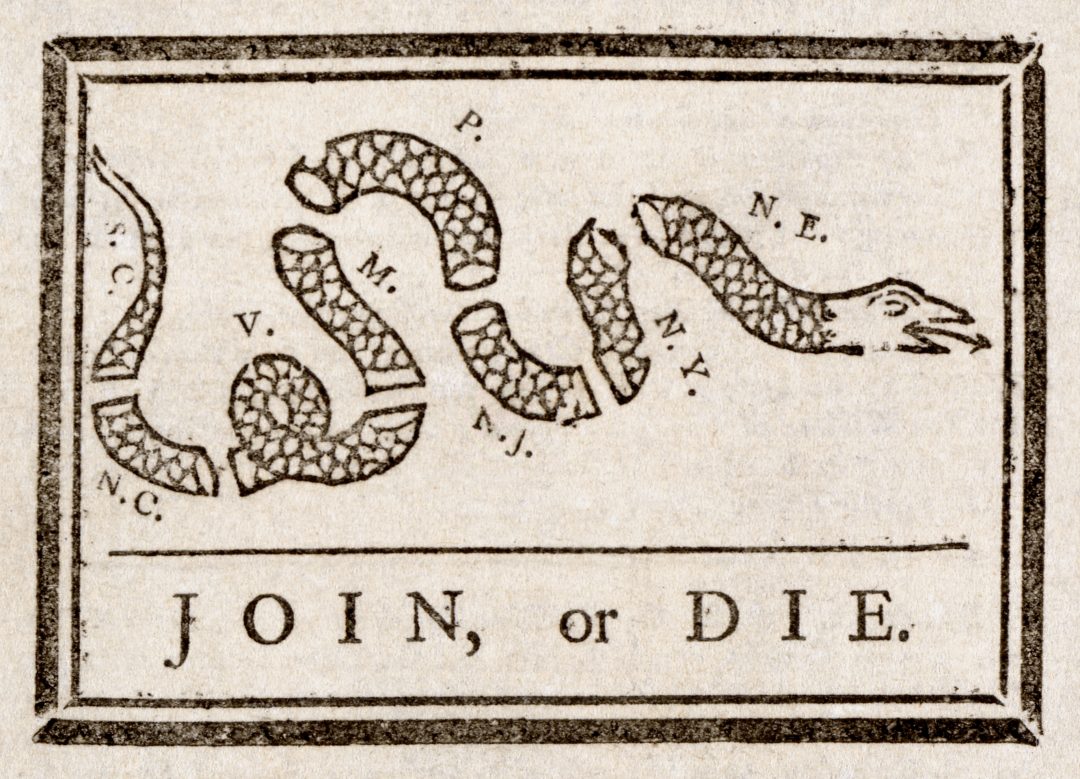Join, or Die: The Power of Pieces
The Join, or Die political cartoon can be described as one of the most symbolic and well-known images created in American history. Benjamin Franklin is credited with producing the cartoon in 1754 during the beginning of the French and Indian War, which lasted from 1754-1763. This war was a major global conflict fought between Britain and France over control of territory and trade in North America and India. The cartoon is made up of a snake that has been cut into pieces, representing the British American colonies and was initially published in The Pennsylvania Gazette by Benjamin Franklin.
The inspiration for the cartoon came from Franklin’s major concern about the lack of unity among the American colonies. The French and Indian War posed a threat for the American colonies for many reasons. Britain and France were fighting for land and power in North America, and at this point the American colonies were still part of the British Empire, so if France were to win there would be several harmful repercussions. To be more specific, this could have meant the loss of land, trade, and protection for the American colonies. Benjamin Franklin was aware of the type of danger and had been thinking about unity in America for a number of years, but with the latest threat from the French, he realized it was time for action.[1] The threat from the French that pushed Franklin’s concern to the limit was their military moving into the Ohio River Valley. History shows that Franklin sent the cartoon, annotated by a paragraph detailing French atrocities, to Pennsylvania’s agent in London, asking him to have the cartoon printed in London papers.[2] Franklin wanted this publish that word could spread fast. The purpose of his cartoon was to try to persuade the leaders of the colonies to unite and form a strong alliance that would soon be essential for survival.
At first sight, the cartoon itself looks like a snake body that has been broken up into eight separate pieces. Although when you take a longer and more detailed look it is much more than that. The cartoon is a woodcut, when the artist carves the image into a wooden block, adds ink and presses it onto paper.[3] The carving and image show that each segment of the snake is meant to represent a colony, and the snake is broken up to symbolize the division between the colonies. The colonies included in the cartoon from the tail of the snake to the mouth include, “S.C.”, “N.C.”, “V.”, “M.”, “P”, “N.J.”, “N.Y.”, and “N.E.”. The slogan “Join, or Die” clearly depicts Franklin’s worry that unless the colonies join together to fight back against the French and present themselves as a united front, they will die. Then the animal of snakes evoked the virile American wilderness and the equality supposedly found there.[4] The specific use of a snake was meant to symbolize the strong and untamed nature of the American land that needed to be protected. Franklin believed that if the colonies decided to stand together and equally rather than alone, they would be more powerful and hopeful of their situation.
Franklin created this impactful cartoon with more than just the hopes to unite the colonies, he also made it to help promote the Albany Plan of Union. The Albany Plan of Union was a plan of action that Benjamin Franklin also came up with. This idea suggested again that the colonies needed to join together and work under one unified government. For instance, the hope was that it would have established a trans colonial governing body, with representatives from each colony and an executive chosen by the crown.[5] Franklin presented this proposition at the Albany Congress in June of 1754, about one month after the cartoon was published. This meeting included many leaders of the American colonies and Franklin described to them that each colony’s separate governments would remain but there would be an additional council to vote on shared issues and obstacles, although his plan did not pass. Franklin’s attempt at both the cartoon and his plan of bringing colonies together highlights the true concern that he felt for the safety of America during this time in history.
In conclusion, Franklin’s creation of the Join, or Die was meant to persuade and convince the leaders of the colonies to unite and stand together against the French. Despite the unsuccessful Albany Plan of Union, Join, or Die did have an important impact on unity and symbolism in America. The cartoon highlighted a new way to send a message to the people and showed how an image can hold power and political views. Furthermore, it started the conversation of unity and a collective identity for America. Lastly, the cartoon will forever serve as a reminder of Benjamin Franklin’s want for the unified colonies to help protect the people of America.
https://www.loc.gov/item/2002695523/
https://constitutioncenter.org/blog/the-story-behind-the-join-or-die-snake-cartoon
Foot Notes
[1] David Copeland, “Join or Die: America’s Newspaper during the French and Indian War.” Journalism History 24, Number 3 (Fall 1998): 112-119.
[2] Alan Kulikoff, “Benjamin Franklin and the Theater of Empire,” The Pennsylvania Magazine of History and Biography 141, Number 1 (January 2017): 77-90.
[3] Richard Sully, “Accounting for Transformative Moments in the History of the Political Cartoon,” International Journal of Comic Art 16, Number 1 (January 2014): 332-364.
[4] Alan Kulikoff, “Benjamin Franklin and the Theater of Empire,” The Pennsylvania Magazine of History and Biography 141, Number 1 (January 2017): 77-90.
[5] Alan Kulikoff, “Benjamin Franklin and the Theater of Empire,” The Pennsylvania Magazine of History and Biography 141, Number 1 (January 2017): 77-90
